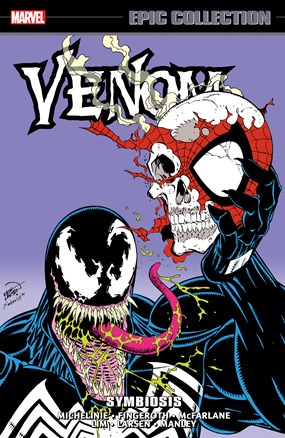Description
Collects Amazing Spider-Man (1963) #258, 300, 315-317, 332-333, 346-347, 388 (B story); Web of Spider-Man (1985) #1; Avengers: Deathtrap - the Vault (1991); Darkhawk (1991) #13-14; material from Amazing Spider-Man Annual (1964) #25-26; Web of Spider-Man Annual (1985) #7-8; Spectacular Spider-Man Annual (1979) #12. Venom goes Epic! When Spider-Man learns that his black costume is secretly an alien symbiote, he rejects the suit - and the spurned creature soon finds a new host! Disgraced reporter Eddie Brock has reasons of his own to hate Spider-Man, and together the two merge into the twisted engine of revenge known as Venom -and a rivalry for the ages begins! Venom has the same powers as Spider-Man - but he's bigger, stronger and doesn't trigger his spider-sense. And he knows Spidey's secret identity! Against such a dangerous, determined and deadly foe, how far will Spider-Man have to go to survive?
About the Author
Tom DeFalco’s earliest comic-book scripts were for Archie and DC; he soon moved to Marvel, where he wrote Avengers, Machine Man and other titles, also launching Dazzler, a hit series of the early ’80s. In addition to writing long and well-received runs on Amazing Spider-Man and Thor, DeFalco edited many titles, eventually becoming editor in chief. During the 1980s, he headed the creative team that provided fictional biographies for G.I. Joe members, originally included with Hasbro’s toys and later used as the basis for multiple storylines on the animated series. Perhaps his best-known work is multi-title character Spider-Girl, whom he introduced in 1998. DeFalco has authored multiple books, including Ultimate Guides for Avengers, Fantastic Four, Hulk and Spider-Man.
Bob Layton began as a prolific and popular inker for Charlton, Marvel and DC Comics, where he first teamed with longtime collaborator David Michelinie on Claw the Unconquered and Star Hunters. The Michelinie-Layton duo’s writing work on Iron Man (1978-1982 and 1987-1989) is one of the most popular and influential interpretations of that character. Leaving Marvel in 1990, he became a key writer/artist/editor at Valiant Comics, where he co-created characters such as X-O Manowar and rose to the post of editor in chief before departing. He still does occasional freelance work for DC and Marvel, notably Michelinie-Layton reunion projects Iron Man: Bad Blood (2000), Iron Man: Legacy of Doom (2008) and Iron Man: The End (2009).
Few can match Ron Frenz’s record of substantial stints on two of comicdom’s most influential and revered characters, Spider-Man and Superman, both of whom he provided with controversial new looks. Frenz succeeded John Romita Jr. on Amazing Spider-Man, and his artwork was favorably compared to Steve Ditko’s original web-slinger. With Roger Stern, he introduced the Hobgoblin, covering the mysterious villain’s debut and revealing his identity more than a decade later in Hobgoblin Lives. With writer Tom DeFalco on Thor, Frenz debuted a new look and identity for Marvel’s Thunder God, eventually branching into Thunderstrike. Later, Frenz and DeFalco launched the MC2 Universe, home of Spider-Girl, the only Marvel heroine to reach 100 consecutive issues.
After a start as inker to his older brother John, Sal Buscema penciled Captain America, Defenders, Incredible Hulk and more. Famed for his ability to meet tight deadlines, he spread his talents across multiple genres. His 1970s work ranged from Ms. Marvel and Nova to Sub-Mariner and Spider-Woman’s first appearance in Marvel Spotlight. He was the uninterrupted artist on Spectacular Spider-Man for more than 100 issues and penciled the web-slinger’s adventures in Marvel Team-Up, in which he and writer Bill Mantlo introduced Captain Jean DeWolff. After handling more team-ups in the Thing’s Marvel Two-in-One, he reunited with brother John on Steve Englehart’s Fantastic Four. He later provided inks for Tom DeFalco’s Spider-Girl titles and Thunderstrike miniseries.
